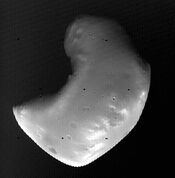Template:Are You Sure/October 5: Difference between revisions
Jump to navigation
Jump to search

No edit summary |
No edit summary |
||
| Line 1: | Line 1: | ||
[[File:Deimos_-_Viking_1.jpg|link=|175px|thumb|'''[[Viking 2 (nonfiction)|Viking 2]]''' Orbiter image of the Martian satellite Deimos taken from 1400 km. Deimos is about 14 km from top to bottom in this image. Date: 5 October 1977.]] | [[File:Deimos_-_Viking_1.jpg|link=|175px|thumb|'''[[Viking 2 (nonfiction)|Viking 2]]''' Orbiter image of the Martian satellite Deimos taken from 1400 km. Deimos is about 14 km from top to bottom in this image. Date: 5 October 1977.]] | ||
• ... that the '''[[Viking 2 (nonfiction)|Viking 2]]''' spacecraft was part of the American Viking program to Mars, and consisted of an orbiter and a lander essentially identical to that of the Viking 1 mission? | |||
• ... that mathematician '''[[Benjamin Peirce (nonfiction)|Benjamin Peirce]]''' (4 April 1809 – 6 October 1880) made contributions to celestial mechanics, statistics, number theory, algebra, and the philosophy of mathematics; and that Peirce famously stated: "Mathematics is the science that draws necessary conclusions"? | • ... that mathematician '''[[Benjamin Peirce (nonfiction)|Benjamin Peirce]]''' (4 April 1809 – 6 October 1880) made contributions to celestial mechanics, statistics, number theory, algebra, and the philosophy of mathematics; and that Peirce famously stated: "Mathematics is the science that draws necessary conclusions"? | ||
Revision as of 03:23, 5 October 2020

Viking 2 Orbiter image of the Martian satellite Deimos taken from 1400 km. Deimos is about 14 km from top to bottom in this image. Date: 5 October 1977.
• ... that the Viking 2 spacecraft was part of the American Viking program to Mars, and consisted of an orbiter and a lander essentially identical to that of the Viking 1 mission?
• ... that mathematician Benjamin Peirce (4 April 1809 – 6 October 1880) made contributions to celestial mechanics, statistics, number theory, algebra, and the philosophy of mathematics; and that Peirce famously stated: "Mathematics is the science that draws necessary conclusions"?